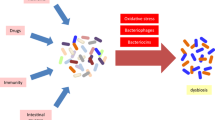Summary
Mucin histochemistry on sections of colon from germ-free and conventional mouse pups showed that all goblet cell mucins were sulphated at birth. During the first two weeks of post natal development, the pattern of mucin production in the ascending colon changed to a distribution of non-sulphated mucins towards the apical zone of the crypts and sulphated sialomucins basally. In conventional animals during the third postnatal week when the complex micro-flora of the colon was becoming established, the typical adult mucin distribution pattern developed, with sulphated mucins now confined to the upper third of the crypt. However, in the absence of a colonizing micro-flora crypt mucins become more and more sulphated until at weaning, most goblet cells of the ascending colon were producing fully or partially sulphated mucins, except for one or two cells at the very base of the crypt.
Similar content being viewed by others
References
Bogomoletz, W. V., Filipe, M. I. &Potet, F. (1984) Intérêt de l'histochimie des mucines dans le tube digestif normal et pathologique.Gastroenterol. Clin. Biol. 8, 364–72.
Bogomoletz, W. V., Williams, G. T. &Potet, F. (1987) HID-bleu Alcian (“high iron diamine-alcian blue”) et histochimie des mucines en pathologie colique: vingt ans après.Gastroenterol. Clin. Biol. 11, 865–8.
Boland, C. R., Montgomery, C. K. &Kim, Y. S. (1982) Alterations in human colonic mucin occurring with cellular differentiation and malignant transformation.Proc. Natl. Acad. Sci. USA 79, 2051–5.
Brackett, K. A. &Townsend, S. F. (1980) Organogenesis of the colon in rats.J. Morphol. 163, 191–201.
Cheng, H. (1974) Origin, differentiation and renewal of the four main epithelial cell types in the mouse small intestine II. Mucous cells.Am. J. Anat. 141, 481–502.
Colony, P. C. (1983) Qualitative changes in glycoprotein staining characteristics in the rat colonic mucosa during development.Gastroenterology. (Abst.) 34, 1129.
Helander, H. F. (1973) Morphological studies on the development of the rat colonic mucosa.Acta anat. 35, 153–76.
Henning, S. J. (1981) Postnatal development: coordination of feeding, digestion, and metabolism.Am. J. Physiol. 241, G199-G214.
Herbst, J. J. &Sunshine, P. (1969) Postnatal development of the small intestine of the rat at weaning.Pediat. Res. 3, 27–33.
Hill, R. R. H. &Cowley, H. M. (1988) Effects of bacterial colonization on the mucosal structure of the large bowel of neonatal rats.Acta anat. 132, 230–3.
Lamont, J. T. &Ventola, A. S. (1980) Purification and composition of colonic epithelial mucin.Biochim. Biophys. Acta 626, 234–3.
Liau, Y. H. &Horowitz, M. I. (1976) The importance of PAPS in determining sulfation in gastrointestinal mucosa.Digestion 14, 372–5.
Neutra, M. R. &Forstner, J. F. (1987) Gastrointestinal mucus: synthesis, secretion and function. In:Physiology of the gastrointestinal tract, (edited byJohnson, A.), pp. 975–1009. New York, Raven Press.
Shamsuddin, A. K. M. &Trump, B. F. (1981a) Colon epithelium I. Light microscopic, histochemical, and ultrastructural features of normal colon epithelium of male Fischer 344 rats.J. Nat. Canc. Inst. 66, 375–88.
Shamsuddin, A. K. M., Weiss, L., Phelps, P. C. &Trump, B. F. (1981b) Colon epithelium IV. Human colon carcinogenesis. Changes in human colon mucosa adjacent to and remote from carcinomas of the colon.J. Anat. Canc. Inst. 66, 413–19.
Sliomany, B. L., Murty, V. L. N. &Sliomany, A. (1980). Isolation and characterization of oligosaccharides from the rat colonic mucous glycoprotein.J. Biol. Chem. 255, 9719–23.
Spicer, S. S. (1975) Diamine methods for differentiating mucosubstances histochemically.J. Histochem. Cytochem. 13, 211–34.
Sprintz, H., Kundel, D. W., Dammin, G.J., Horowitz, R. E., Scheiner, H. &Formal, S. B. (1961) The response of the germ-free guinea pig to oral challenge with Escherichia coli and Shigella flexnerii.Am. J. Path. 39, 681–95.
Author information
Authors and Affiliations
Rights and permissions
About this article
Cite this article
Hill, R.R.H., Cowley, H.M. & Andremont, A. Influence of colonizing micro-flora on the mucin histochemistry of the neonatal mouse colon. Histochem J 22, 102–105 (1990). https://doi.org/10.1007/BF01885788
Received:
Revised:
Issue Date:
DOI: https://doi.org/10.1007/BF01885788




